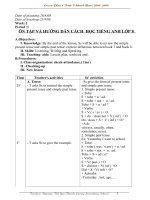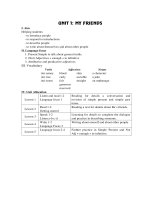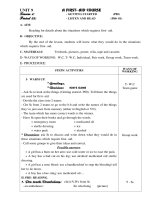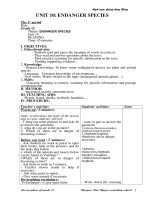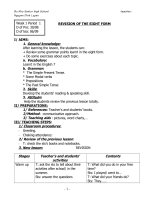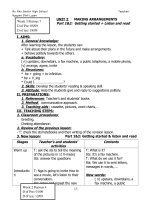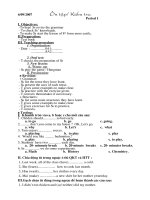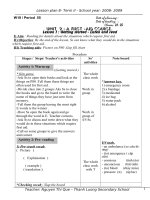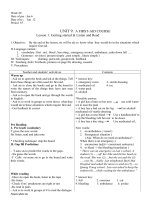Giáo án Anh 8 ( 09- 10)
Bạn đang xem bản rút gọn của tài liệu. Xem và tải ngay bản đầy đủ của tài liệu tại đây (1.21 MB, 376 trang )
English l esson plan
8
Term i
school year : 2008 - 2009
Period 1: Revision
PLANNING DAY TEACHING DAY
I AIM:
Help Ss review and consolidate some old grammar structures
they have learnt before.
II OBJECTIVE:
By the end of the lesson, students will use some old grammar
structures better and get used to English 8.
III MATERIALS: Textbook, poster.
IV the content of revision:
1 Tenses:
1. Present Simple: V-inf/ V-s/ V-es
2. Present Continuous: am/ is/ are + V-ing
3. Past Simple: V-ed/ V2
4. Simple Future: will/ shall + V-inf
5. Near Future: am/ is/ are + going to + V-inf
2 Modals: may, might, should, ought to, can....
Modal + V-inf
3 Comparison:
A, Equal Comparison:
(+) ...... as + adj/adv + as......
(-) ......not as/ so + adj/ adv + as......
B Comparative:
- ....... short adj/ adv + -er + than........
- ....... more + long adj/ adv + than.........
C Superlative:
- - ....... the + short adj/ adv + -est + than........
- ....... the most + long adj/ adv .........
4- Further Practice:
- Write some exercises about the grammar Ss have reviewed
on the board.
- Ask Ss to do the exercises.
- Give feedback and correct.
- Ask Ss to copy.
-
Introduce the form of a unit in English 8:
Each unit of English 8 has 7 parts (6 lessons):
- Getting started.
- Listen and read.
- Speak.
- Listen.
- Read.
- Write.
- Language Focus.
UNIT 1: MY FRIENDS
I. Aim Helping students:
- to introduce people
- to respond to introductions
- to describe people
- to write about themselves and about other people
II. Language focus
1. Present Simple to talk about general truths.
2. (Not) Adjectives + enough + to infinitive
3. Attributive and predicative adjectives.
III. Vocabulary
Verbs Adjectives Nouns
(to)annoy blond slim a character
(to) rise curly sociable a joke
(to) seem fair straight anorphanage
generous
reserved
IV. Unit Allocation
Lesson 1
Listen and read 1-
2
Language focus 1
Reading for details a conversation and revision of
simple present and simple past tense.
Lesson 2
Read 1-2
Getting started
Reading a text for details about Ba’s friends.
Lesson 3
Speak 1-2
Listen a-b-c-d
Listening for details to complete the dialogue and
practice in describing someone.
Lesson 4
Write 1-2
Language Focus 3
Writing about oneself and about other people
Lesson 5
Language focus
2-4
Further practice in Simple Present and Not Adj +
enough + to-infinitive
UNIT 1: MY FRIENDS
PLANNING DAY TEACHING DAY
Lesson 1: Section: - Listen and read (page 10,11)
Period 2 - Language focus 1 (page 16)
I Aim:
Reading the dialogue and revision of simple present and simple
past tenses.
II Objective:
By the end of the lesson, students will be able to know more about
Hoa – Lan – Nien and to review simple present and simple past
tense.
III Teaching aids:
Text book, cards
PROCEDURE
Stage Steps/Activities Work
arrangement
Warm up * Pelmanism:
- Prepare twelve cards with numbers on one side and
the verbs on the other.
- Make sure the verbs are mixed up. Stick the cards
on the board so students can only see the numbers.
- Divide students into two teams and ask them to
choose two numbers.
- Turn the cards over and see if they match .
Eg: teach - taught, give them one mark. If not, turn
Group work
Pre-reading
While reading
the cards over again and ask the next team.
- Continue until all the cards are finished.
meet come live think send though
receive met lived received came Sent
I. Pre-teach vocabulary
- to seem (translation)
- a next door neighbor (explanation: a person who
lives next to your house)
- to look like: (translation)
* Checking vocabulary: Rub out and remember
- Rub out the new words one a time.
- Each time you rub out an English word, point to the
Vietnamese translation and ask “what's this in
English?"
- When all the English words are rubbed out go,
through the Vietnamese list and get students to call
the English words.
- If there's time, get students to come to the board and
write the English words again.
II. Pre- questions
- Give students some questions and ask them to work
in pairs to answer them.
a. Is Nien Lan's friend or Hoa's friend?
b. How old is Nien?
c. Where does Nien live?
d. Is she a beautiful girl?
- Give feedback
- Ask students to read the dialogue between Hoa, Lan
and Nien on page l0 and check if their answers are
correct or not.
* Answers:
Whole class
Pair work
T-Whole class
Pair work
a. She is Hoa's friend
b. She 's twelve years old.
c She lives in Hue.
d. Yes, she is.
I. Comprehension questions
- Ask students to read the dialogue again and answer
the questions in exercise 2 on page 11 (work in pairs)
a. Where does Nien live?
b. Does Lan know Nien?
c. Which sentence tells you that Hoa is older than
Nien?
Pair work
d. When is Nien going to visit Hoa?
* Answers:
a. Nien lives in Hue.
b. No, she doesn't.
c. The sentence is “She wasn't old enough to be in my
class”.
d. At Christmas
- Call on some students to ask and answer the
questions.
- Correct their mistakes or pronunciation.
- Ask them to work in closed pairs.
II. Gap-filling
- Ask students to use the simple present and simple
past tense to complete paragraph 1 (a) on page 16.
- Provide some verbs so that students can use them to
fill in the gaps.
- live (2) – send - be(2) - come
“ Hoa (1) in Hue last year, but now she (2) in Hanoi.
Yesterday, Hoa's friend Nien (3) Hoa a letter. Nien
(4) Hoa's neighbor when Hoa lived in Hue. She (5)
younger than Hoa. She (6) to Hanoi in December.
* Answers:
Open pairs
Closed pairs
In dividual
Work
Post reading
(1) lived (2) lives (3) sesen
(4) was (5) is (6) comes
- Ask students to work individually and then compare
their answers with their partners.
- Give feedback.
* Writing:
- Ask students to write a paragraph about Hoa and
Lan.
- Give students some cues and ask them to use the
simple present or simple past tense to write
individually.
Pair work
Whole class
Individual
work
Homework
* Cues:
a. Lan / Hoa's best friend
b. The same class / Quang Trung School.
c. Last year / Hoa / to school first time.
d. Lan / show / around / introduce / to new friends .
- Let students discuss with their partners.
- Choose some answers and correct them in front of
the class.
- Ask students to do exercise 1(a); 1(b) on their
notebooks .
Pair work
T-whole class
UNIT 1: MY FRIENDS
PLANNING DAY TEACHING DAY
Lesson 2: Section: - Speak (page 11)
Period 3 - Listen (page 12,13)
I Aim:Listening for details to complete the dialogue and speak to
describe someone.
II Objective:By the end of the lesson, students will be able to
describe somoen and complete the dialogue by listening.
III Teaching aids:Text book, pictures
PROCEDURE
Stage Steps/Activities Work
arrangement
Warm up
* Brainstorming:
- Ask students to think of the adjectives used to
describe body build and hair.
thin curly
Whole class
* Possible answers:
- fat - straight
body
build
hair
Presentation
- slim - long
- tall - short
- short black/dark
- overweight - color blond/fair
Brown
grey
- slender
- Show students a picture of Mary and ask them to
describe her hair, her body build.
Ex: She has long blond bair.
She is short and thin.
Form:
S + have / has + adjectives + hair
S + be + adjectives
T-Whole class
Practice I. Word cue drill
- Prepare 6 cards so that students can drill easily.
a. he / tall / thin He is tall and thin
b. She/short / slim She is short and slim.
c. He/ short / fat He is short and fat.
d. long / black She has long black hair.
e. curly / blond She has curly blond hair.
f. straight/ brown She has straight brown hair.
II. Practice Speaking
- Show the posters of six people / or ask students to
look at six people on page 11-12.
- Call on a student to describe one person, the others
have to guess who he/she is.
Example: S1: This person is short and thin. She has
long blond hair.
Whole class
Whole class
S2: Is this Mary?
Yes
- Go on until six people on the poster are described.
Pre-listening
While
listening
- If there’s time, ask students to describe a famous
person or one of their classmates and their friends
have to guess.
- Ask students to do exercise "Listen a, b, c, d." on
page 12-13.
- Give students some expressions and make sure they
know their meanings.
- Get students to guess and to complete four
dialogues on page 12-13, using the given expressions.
- Give feedback.
- Let students listen to the tape twice. .
- Get students to work in pairs to complete the
dialogues and compare with their prediction.
* Tape transcript:
a,Hoa: Hello, Nam.
Nam: Morning, Hoa.
Hoa: Nam, I’d like you to meet my cousin, Thu.
Nam: Nice to meet you, Thu.
Thu: Nice to meet you too, Nam.
b,Khai: Miss Lien, I’d like you to meet my mother.
Miss Lien: It's a pleasure to meet you, Mrs.
Mrs. Vi: The pleasure is all mine, Miss Lien.
Miss Lien: Oh, there is the principal.
Please excuse me, Mrs. Vi, but I must talk to
him.
Mrs. Vi: Certainly.
c,Ba: Bao, come and meet my grandmother.
Individual work
Pair work
Bao: Hello, ma'am.
Grandmother: Hello young man.
Ba: Bao is my classmate, grandmother.
Grandmother: What was that?
Ba: Classmate! Bao is my classmate.
Grandmother: I see.
Post-listening
d,Mr. Lam: Isn't that Lan's father, my dear?
Mrs. Linh: I'm not sure. Go and ask him.
Mr. Lam: Excuse me. Are you Mr. Thanh?
Mr. Thanh: Yes, I am.
Mr. Lam: I'm Lam, Nga's father.
Mr. Thanh: How do you do?
- Ask students to practice speaking the dialogues.
- Call on some students to play the roles of Nam -
Hoa Thu; Khai - Mrs. Lien - Mrs. Vi; Ba-Bao
Grandmother; Mr. Lam - Mrs. Linh - Mr. Thanh and
practice the dialogues.
- Correct their pronunciation.
- Let students work in pairs to practice the dialogues.
(closed pairs).
Open pairs
Closed pairs
UNIT 1: MY FRIENDS
PLANNING DAY TEACHING DAY
Lesson 3: Section: - Getting started (page
10)
Period 4 - Read (page 13,14)
I Aim:
Reading for specific information
II Objective:
By the end of the lesson, students will be able to know more
about Ba’s friend.
IIITeaching aids:
PROCEDURE
Stage Steps/Activities Work
arrangement
Warm up
Pre-reading
Chatting:
- Ask students to look at four pictures on page 10 and
talk about the activities they want to do after school
or in their free time.
- Give them some questions.
• What are these students doing?
(play soccer / play chess / read books / play volley
ball)
• What time of the day do you think it is? (in the
morning / evening, after school)
• Do you like soccer / reading books ...?
• Whom do you like playing with?
I. Pre-teach vocabulary:
- a character: (translation)
- an orphanage: (explanation: a place where children
without parents live)
- reserved (adj)
- sociable: (adj) (Translation)
- (to) tell jokes: (explanation: tell a story which
makes people laugh)
- sense of humor (translation)
* Checking vocabulary: what and where
- Write the word on the board, put one word in each
circle.
T-whole class
Whole class
Reserve
d
characte
r
sociable
tell
jokes
orphanag
e
Sense
of humor
- Have students repeat the words in chorus then rub
out word by word but leave the circles.
While reading
- Go on until all the words are rubbed out.
- Point to each circle and ask students to repeat
chorally the English words.
Ask students to go to the board and write the words
again in the correct circles.
II. T /F statements prediction
- Stick the poster of T / F statements on the board.
- Set the scene: These statements are about Ba and
his friends, read them and gues which statements are
true, which are false.
- Get students to work in pairs.
a. Ba only has three friends - Bao, Song, Khai
b. Ba and his friends have the same characters
c. Bao - Song - Khai are quite reserved in public.
d. They all enoy school and study hard.
- Give feedback.
- Ask students to open their books and read the text
on page 13.
- Let students check their prediction.
Guess Correct
a.
b.
c.
d.
F
F
F
T
- Ask students to correct false statements.
* Correction:
a. Ba has a lot of friends but he spends most of his
time with Bao, Song and Khai.
Pair work
Pair work
b. They have different characters.
c. Only Song and Khai are quite reserved.
I. Multiple choice
- Get students to do exercise 1 on page 14.
Pair work
- Ask them to work in pairs to choose the best
answers.
* Answers:
a. Ba talks about three of his friends.
b. Bao's volunteer work does not affect his school
work.
c. Khai and Song are rather shy.
d. Ba's friends sometimes get tired of his jokes.
- Explain the meanings of the phrases:
• doesn't affect his school work (không ảnh hưởng tới
việc học)
• rather shy (h¬i nhót nh¸t)
• get tired of ( nhµm ch¸n)
II. Comprehension questions
- Ask students to work in pairs to do exercise 2 on
page 14.
- Let students read the text again and answer the
questions.
* Questions and answers:
a. How does Ba feel having a lot of friends?
(He feels lucky having a lot of friends.)
b. Who is the most sociable?
(Bao is the most sociable.)
c. Who likes reading?
(Khai likes reading.)
Pair work
Pair work
d. What is the bad thing about Ba's jokes?
(His jokes sometimes annoy his friends.)
e. Where does Bao spend his free time?
(Bao spends his free time doing volunteer work at a
local orphanage.
f. Do you and your close friends have the same or
different characters? (students' answer)
- Call on some pair of students to ask and answer the
Pair work
Post reading
Home work
questions. Teacher corrects their pronunciation.
- Ask all students to work in closed pairs.
- Ask students to work in groups and talk to one
another about their friends, using the adjectives they
have just learnt to describe.
- Ask each student to write a paragraph (about 50
words) about one close friend.
Group work
UNIT 1: MY FRIENDS
PLANNING DAY TEACHING DAY
Lesson 4: Section: - Write (page 15)
Period 5 - Language Focus 3 (page 17)
I Aim: Writing about oneself and about other people.
II Objective: By the end of the lesson, students will be able to
write a paragraph about their close friends.
III Teaching aids:Text book, pictures
PROCEDURE
Stage Steps/Activities Work
arrangement
Warm up
Kim's game:
- Ask students to look at the picture on page 17
quickly (for 20 seconds). Then let them keep their
books closed.
- Divide the class into four groups.
- Give students two questions, the group which
answers correctly the fastest wins the game.
a. How many people are there in the picture? (Four)
b. What is each person wearing?
- The woman is wearing a red shirt and a green skirt.
Group work
- The man who is standing beside the car is wearing
brown trousers and a yellow shirt.
- The man who is standing on the pavement is
wearing a pink shirt and blue trousers.
Pre-writing
While writing
- The boy is wearing blue shorts and a white shirt.
* Reading:
- Ask students to read the information about Tam then
answer some questions.
a. What is his name?
(Le Van Tam)
b. How old is he?
(14)
c. What does he look he?
(He is tall and thin. He has short black hair.)
d. What is he like?
(He is sociable, humorous and helpful.) 1
e. Where does he live?
(He lives at 26 Tran Phu Street, Hanoi)
f. Whom does he live with?
(He lives with his mother, father and an elder
brother.)
g. Who is his friend?
(Ba and Bao)
- Let students write a paragraph about Tam, using the
information they have just got.
They have to work individually.
- Ask students to compare with the paragraph in their
books on page 15.
- Ask students to write some information about one of
their friends, then wrrite a paragraph about him or
her.
- Get students to share with their partners and
conrrect if possible.
T-Whole class
Individual work
Pair work
* Sample:
His / her name is ............ and homework / she
is........... years old. He / she.......lives at.......in with his
grandmother, his parents and his younger sister, Mai.
Post- writing
Homework
He / she is tall and slender. He / she has short black
hair. He / she rather shy but friendly and helpful. He /
she has a lot of friend but his / her close friends
are ............... and ……………..
- Ask each student to write a similar paragraph about
himself / herself.
- Move around the class and help students, then ask
some students to speak in front of the class about
himself / herself.
- Ask students to wnte another paragraph about one of
their family members.
Individual work
UNIT 1: MY FRIENDS
PLANNING DAY TEACHING DAY
Lesson 5: Section: - Language Focus 2 (page 16)
Period 6 - Language Focus 4 (page 17)
I Aim:
Further Practice in simple present tense and the structure.
II Objective:
By the end of the lesson, students will be able to use simple
present tense to talk about general truths and write some
sentences using the structure” (not) + adjectives enough + to-
infinitive”
III Teaching aids:
Text book, cards, pictures
PROCEDURE
Stage Steps/Activities Work
arrangement
Warm up * Categories:
- Ask students to find out the adjectives beginning
with the letters that the teacher gives.
- Divide the class into two groups.
- Give four letters at the same time, students are to
find out four adjectives begining with the four letters
given.
Example:
T writes : a b c d
S writes: awful big clever dirty
T writes: g h i j
S writes: great heavy intelligent jealous
T writes: k 1 m n
S writes: kind lovely mean new
T writes: o p q r
S writes: old poor quiet rich .
- The team which finishes first gets one mark.
* Checking vocabulary:
- Call on two students or two teams of students (5
students each tham) to the front of the class .
- Make sure they stand at an equal distance from the
board.
- Call out one new word in Vietnamese, the two
students must run forward and slap the word on the
board. (in English ). The one who first slaps the
correct word is the winner.
- Continue to ask two more students to come forward .
- Go on until students have slapped all the words .
II. Revision of Simple Present Tense
- Review simple present tense: formation, usage.
T-whole class
T-whole class
Focus on one of the usage of Simple present tense. It
Practice
Presentation
2
is used to express an action which is always true.
- Give students five verbs: be-move-set-rise- go.
- Ask students to complete the dialogue between Ba
and Tuan, his young cousin.
- Get students to work in pairs.
* Answers:
Ba: What do you know about the sun, Tuan?
Tuan: The sun rises in the East and sets in the West.
Ba: Can you tell me anything about the other planets?
Tuan: I know something about the Earth. It goes
around the sun.
Ba: Yes, and the moon moves around the Earth.
Tuan: Where is Mars, Ba?
Ba: It is near the sun.
Tuan: No it's silly! That is Mercury. Mars is near the
Earth.
- Get students to practice the dialogue in pairs. .
- Correct their pronunciation. Focus on the
pronunciation of verbs ending with S/ES.
Set the scene to introduce the structure "(not) +
adjectives enough + to - infinitive". Teacher is to ask
students to hang the picture on the board. "How do I
say and how do you answer? Complete the
exchange."
Can you (1) this (2) over there?
No I (3) not (4) (5) to (6) the (7) over there.
- Answers:
T: Can you hang this picture over there?
S: No, I am not tall enough to hang the picture over
there.
Form: "(not) + adjectives enough + to - infinitive"
Meaning: (®ñ / cha ®ñ….®Ó lµm g×)
Pair work
Pair work
T-whole
class
Practice
I. Word - cue drill
Whole class
Homework
a. Read English books / good
- Can you read English books?
- Yes. My English is good enough to read English
books.
b. Drive a car / x old
- Can you drive a car?
- No. I'm not old enough to drive a car.
c. Carry this bag / strong
- Can you carry this bag?
- Yes. I'm strong enough to carry it.
d. Solve this problem / clever
- Can you solve this problem?
- No. I'm not clever enough to solve the problem.
- Model two cues, the whole class repeats, then ask
some students to repeat individually.
- Make sure students remember the exchange, then
ask a new student / give a new cue.
- Let all students work in pairs, one asks, the other
answers.
II. Further Practice
- Ask students to do exercise 4 on page 17 in pairs.
- Give feedback and ask students to practice the
dialogue.
* Answers:
a. Not big enough.
b. Not old enough.
c. Strong enough.
d. Good enough.
- Ask students to write five sentences about
themselves using the structure: "(not) adjectives
enough + to - infinitive".
Pair work
Pair work
UNIT 2: MAKING
ARRANGEMENTS
PLANNING DAY TEACHING DAY
I AimHelping student
- to talk about intentions
- to use telephone to make and confirm arrangements
- to take a telephone message.
II. Language focus
1. GOING TO talks about intentions and activities in the
future.
2. Adverbs of place
III. Vocabulary
Verbs Adjectives Nouns
(to) agree
(to) arrange
(to) conduct
(to) demonstrate
(to) emigrate
(to) transmit
Commercial
Countless
Mobile
an assistant
deaf – mute
a device
a directory
an exhibition
an experiment
a fishing rod
a message
a stationery
Lesson 1
Listen and read 1-2
Reading the conversation about making and
confirming arrange-ments.
Lesson 2 Speak 1-2
Language Focus 1-2
GOING TO talks about intentions
Lesson 3 Read 1 - 2 Reading the text for specific information about
Alexander Graham Bell
Lesson 4 Write 1-2-3 Writing a message.
Lesson 5 Listen Language Focus 3 Listening for details and practicing adverbs of
place.
UNI T 2: MAKING
ARRANGEMENTS
PLANNING DAY TEACHING DAY
Lesson 1 Section: - Getting started
(page18)
Period 7 - Listen and read
(page 19)
I. Aim:
Reading for details about a conversation on the phone.
II Objective:
By the end of the lesson, students will be
able to use the telephone to make and confirm
arrangements.
IIITeaching aids:
Text book, poster, pictures(on page 18)
PROCEDURE
Stage Steps/Activities Work
arrangement
Warm up
* Ask students to match each object (pictures on page
18) with its name.
* Answers:
a. an answering machine.
b. a mobile phone.
c. a fax machine
d. a telephone directory
e. a public telephone.
f. an address book.
- Give the definitions of these objects on a poster
and ask students to match the object with its
definition.
* Definition:
1. to send fax
2. to find someone's telephone number
3. to write addresses and telephone numbers.
4. to make a phone call in a street telephone box.
5. to leave and take messages.
T-whole class
Pre-
Reading
6. to make phone call anywhere you like.
* Answers:
a-5 b-6c-1d - 2 e-4f-3
* Open prediction:
- Set the scene: "Hoa and Nga are talking on the
phone. They are talking about going to see a movie."
Pair work
